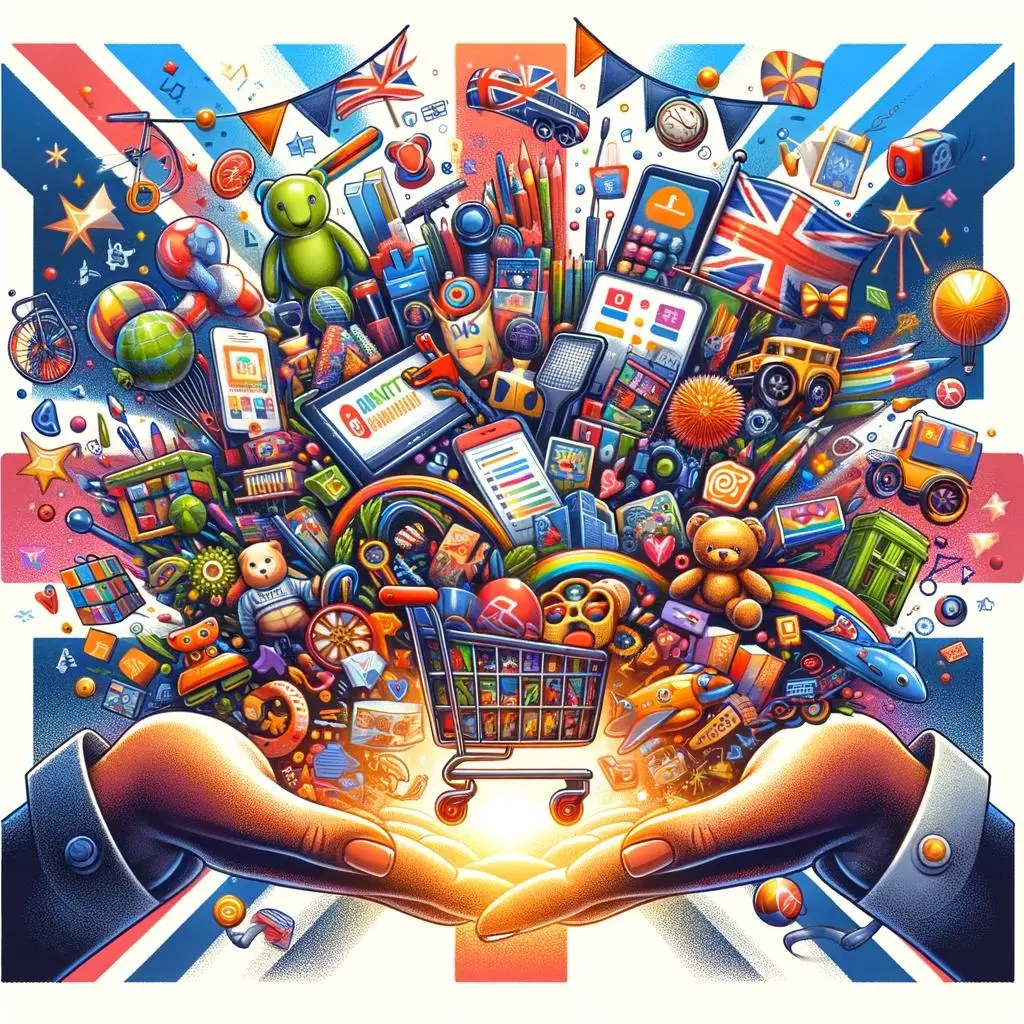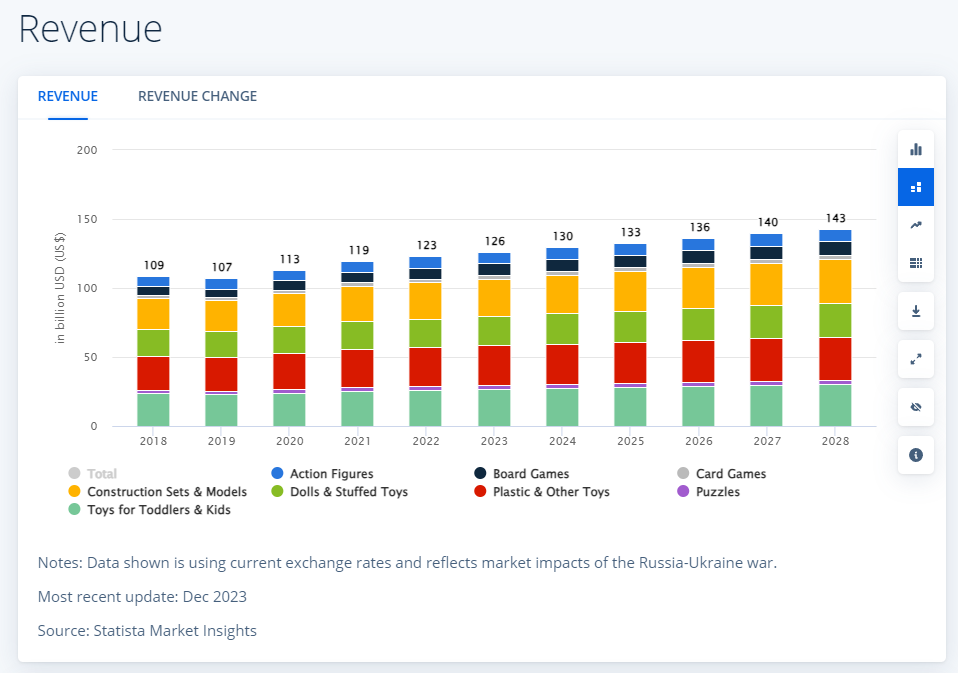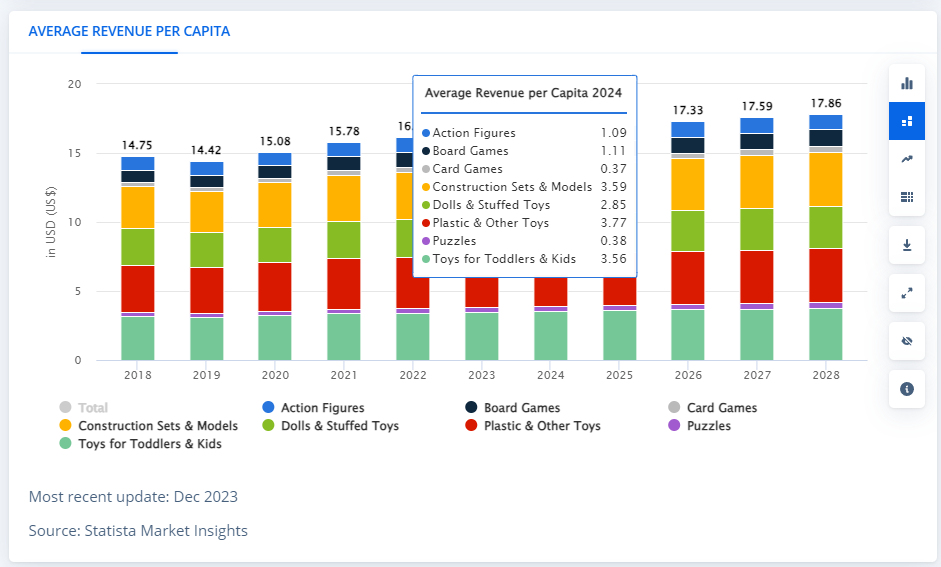The UK toy industry, navigating through a landscape of evolving consumer preferences and digital transformation, stands at a pivotal juncture marked by compelling trends and statistics.
Despite facing challenges such as the impact of Brexit and the presence of counterfeit toys, the sector has shown remarkable resilience and potential for growth. In 2022, the UK toy market was valued at an impressive GBP 4.3 billion, with forecasts predicting a steady compound annual growth rate (CAGR) of more than 1% between 2022 and 2027.
This indicates a positive trajectory for the industry, buoyed by the increasing shift towards online shopping, where 36% of toy sales are now conducted online, complemented by a 14% per year increase in click and collect sales.
Amidst this backdrop, the rise of sustainable toys and the emphasis on safety standards, such as those outlined in the Toys (Safety) Regulations 2011, reflect the industry’s commitment to quality and environmental stewardship.
The market’s inclination towards eco-friendly materials and the surge in collectable toys, which accounted for 9% of the overall UK toy market, underscore the diverse interests of consumers and the opportunities for innovation.
Furthermore, the adaptation of toy manufacturers to the digital age, with a keen focus on online sales channels, illustrates the dynamic nature of the market and its readiness to meet the future demands of consumers.
As the UK toy industry continues to evolve, it stands as a testament to the enduring appeal and importance of toys in both the lives of children and adults, promising a landscape rich with opportunities for growth and innovation.
Table of Contents
ToggleMarket Growth and Projections
1. Global toy sales reached $107.4 billion in 2022, with a 1.5% growth over 2021.
2 The compound annual growth rate (CAGR) for the global toy market was 3.5% over the five-year period since 2017.
3 The global toys market is projected to grow from $141.08 billion in 2021 to $230.64 billion by 2028, with a CAGR of 7.30%.
4. The global toy market size was USD 129.45 billion in 2020 and is projected to reach USD 230 billion by 2028.
5. The global toy market size was valued at USD 65530.35 million in 2022 and is expected to reach USD 101159.97 million by 2028, with a CAGR of 7.5% during this period.
6. The global toys market size reached US$ 183.0 billion in 2023 and is expected to reach US$ 326.0 billion by 2032, exhibiting significant growth.
Online Sales and E-Commerce Trends
7. Tech-savvy children and adults are contributing to the trend of purchasing toys online, with 60% of all toys bought by American parents being bought online.
8. Online distribution channels are expected to grow rapidly, with leading toy manufacturers recognizing the potential of online sales channels.
9. The importance of concrete online marketing strategies for toy manufacturers and industry players is crucial in today’s thriving e-commerce market.
10. Leading toy manufacturers have direct-to-consumer businesses, such as Mattel and Hasbro, recognizing the importance of online sales channels.
11. The post-COVID-19 impact has increased preference for online toy retail platforms as consumers are more comfortable with indoor environments and online shopping trends continue.
Toys & Games - Worldwide Stats 1
Toys & Games - Worldwide Stats 2
Sustainability and Safety Standards
12. The global sustainable toys market was valued at $18,939.1 million in 2020 and is projected to reach $59,643.9 million by 2030, with a CAGR of 12.5%.
13. Sustainable toys are made from biodegradable natural materials such as linen, renewable wood, cotton, bamboo, and water-based inks.
14. The U.S. toy industry adheres to stringent safety standards outlined in ASTM F963 – Standard Consumer Safety Specification for Toy Safety.
15. In the UK, the Toys (Safety) Regulations 2011 outline specific toy safety standards for compliance with regulations governing toys designed for children under 14 years old.
16. Third-party testing and certification are mandatory for toys designed for children aged 12 and under in both the U.S. and the UK.
Emerging Markets and Consumer Trends
17. The STEM toys market is expected to grow substantially between 2023 and 2030, focusing on problem-solving and real-world applications of STEM subjects.
18. Educational toys that enhance academic, social, and emotional development are driving growth in the global toys market.
19. Nostalgia is being used as a marketing tool in the toy industry to drive sales growth alongside personalization and immersive experiences.
20. The emergence of “kidults” has expanded the target audience for toys beyond children to include older demographics.
21. The global toys market is expected to enjoy a CAGR of 7.50% over the next five years (2022 to 2027), driven by the growing demand for educational toys that enhance children’s development.
Product Innovation and Market Dynamics
22. The UK toy market was valued at GBP 4.3 billion in 2022 and is forecast to grow at a compound annual growth rate (CAGR) of more than 1% between 2022-2027.
23. Older individuals are expected to continue entering the toys and games market, while the 5-12 age group remains the dominant consumer segment.
24. Outdoor and sports-related toys, including play tents, airplanes, pools, and other outdoor activity toys, are popular among consumers seeking outdoor entertainment options.
25. Building/construction set toys are also popular, offering engaging and educational play experiences for children.
UK Toy Industry Statistics and Trends FAQs
To find the best deals on toys in the UK, parents should consider subscribing to newsletters from reputable kids coupon and voucher websites, which often provide exclusive discounts and early access to sales. Additionally, following these websites on social media and checking them regularly, especially during major sale seasons like Black Friday, Cyber Monday, and Boxing Day, can help parents catch the best deals. Comparing prices across different retailers and looking for price match guarantees can also ensure parents get toys at the best price.
Intelligent and interactive toys offer numerous benefits for children’s development. They can enhance cognitive skills by encouraging problem-solving and critical thinking. These toys also promote language development and communication skills through interactive play. Moreover, they support emotional and social development by teaching empathy and cooperation. Many intelligent toys are designed with educational purposes in mind, making learning fun and engaging for children.
Adults aged 20-35 are increasingly investing in toys and games for several reasons. For many, it’s about nostalgia and recapturing the joy of their childhood. Others see collecting toys and games as a hobby or a form of investment. Additionally, the rise of “kidults” – adults who enjoy kid-centric products – has led to a broader acceptance of adults engaging in what were traditionally considered children’s activities. This demographic often seeks high-quality, collectible items that offer a sense of exclusivity or uniqueness.
Choosing the right toys for children involves considering their age, developmental stage, and personal interests. For younger children, look for toys that stimulate the senses and encourage exploration, such as soft toys, musical instruments, and simple construction sets. As children grow, toys that challenge their problem-solving skills and creativity, like more complex construction toys, action figures, and art kits, can be more appropriate. Always check the age recommendations on toy packaging and consider the child’s individual interests and abilities to ensure the toy is both safe and engaging.
Disclaimer
The content of this article, including statistics and trends regarding the UK toy industry, is for informational purposes only. We aim to provide accurate and up-to-date information, but the dynamic nature of the market means that details may change. The article’s insights and projections are not guaranteed and should be viewed as opinions rather than facts. We are not responsible for the content of external sites linked within this article, nor do we endorse their views. This article is not intended as professional advice. Use the information at your own risk and discretion.




